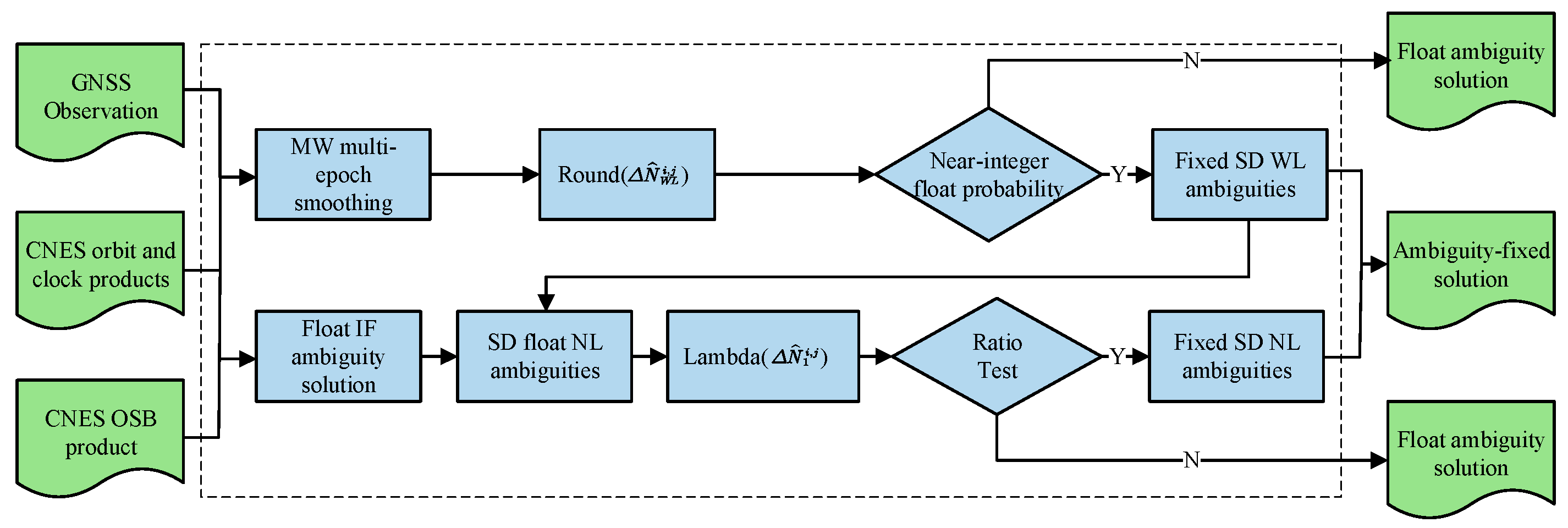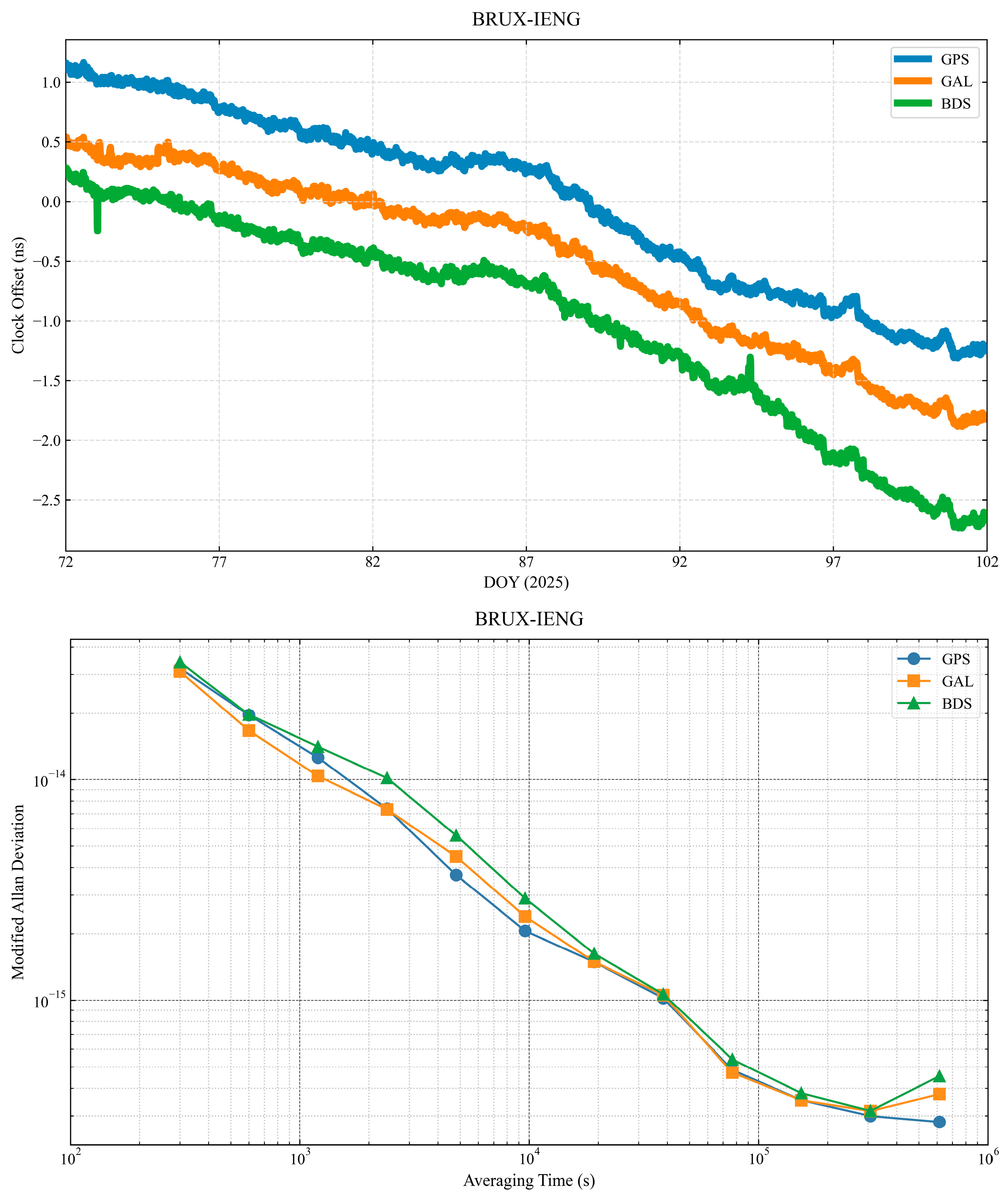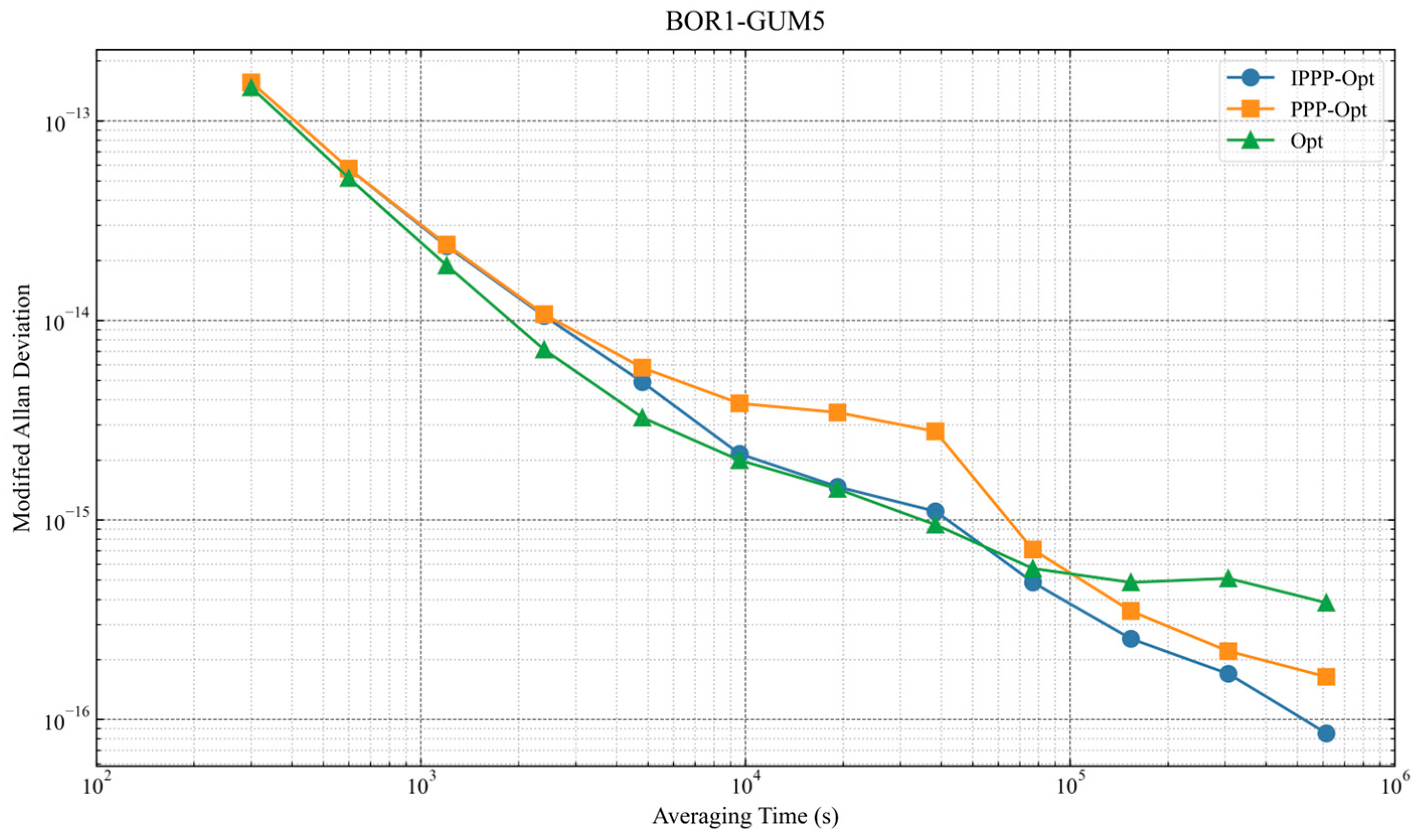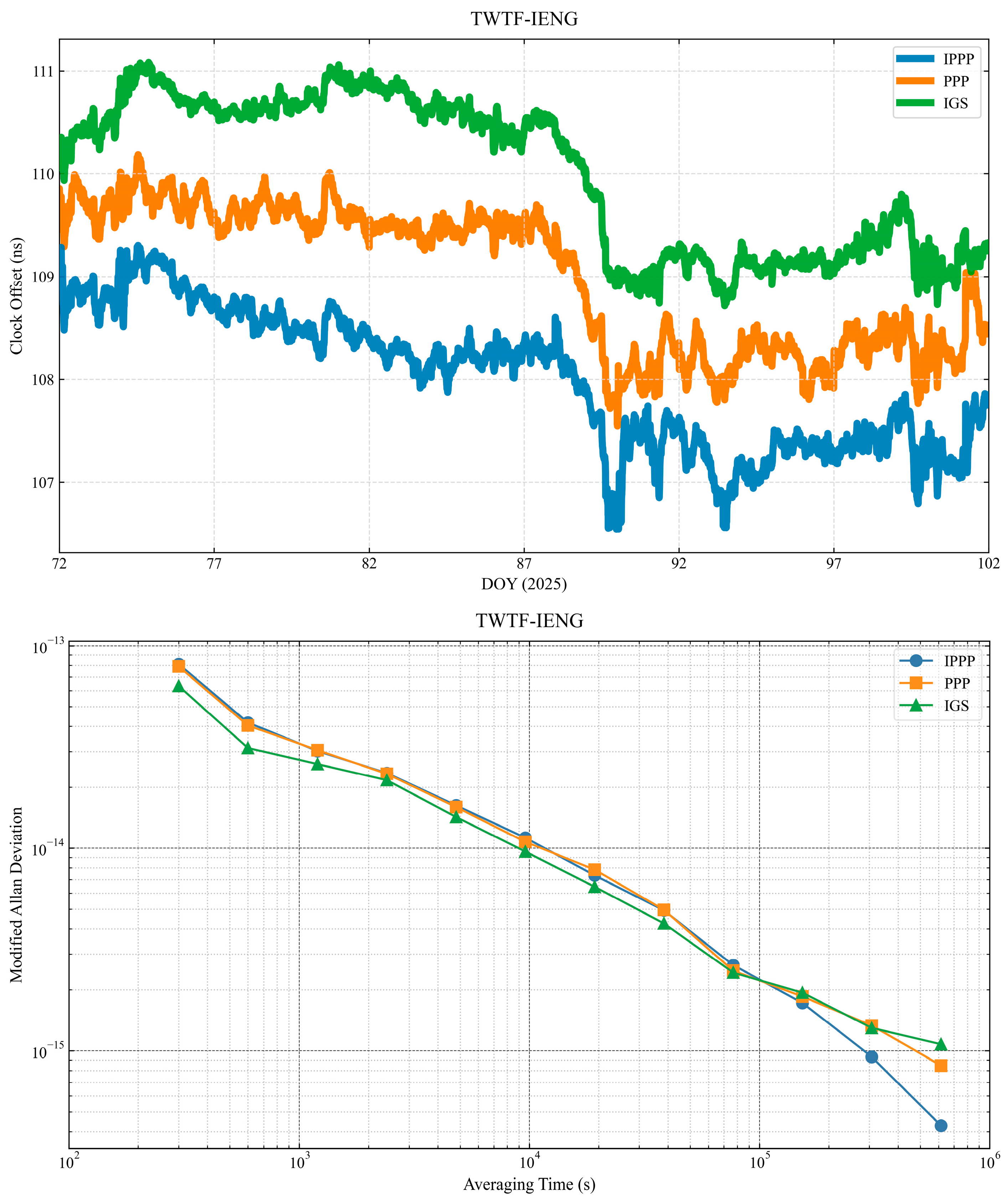2.1. Materials and IPPP Approach
Multi-frequency GNSS Observation Model
For GNSS satellite
s and receiver
r, the multi-frequency pseudorange and carrier-phase observation equations can be expressed as
where
and
denote raw pseudorange and carrier-phase observations, respectively;
represents the frequency index;
is the true geometric range between receiver and satellite;
is the speed of light in a vacuum;
and
are receiver and satellite clock offsets;
is the zenith wet tropospheric delay;
is the mapping function for zenith wet delay tropospheric delay;
is the slant ionospheric delay at the first frequency;
is the ionospheric scaling factor;
is the signal wavelength (m);
denotes the integer carrier-phase ambiguity in units of cycles;
denote receiver/satellite pseudorange hardware delays; likely,
denote receiver/satellite phase hardware delays;
represent pseudorange/carrier-phase observation noise, including multipath effects.
In this study, the following error sources are corrected using established models and thus omitted from the equations: satellite/receiver antenna phase center offsets (PCOs) and variations (PCVs), relativistic effects, solid earth tides, ocean tidal loading, and phase wind-up. For first-order ionospheric delay elimination in dual-frequency scenarios (frequencies 1 and 2), the ionosphere-free combination is applied:
where
denotes the ionosphere-free combination;
and
are the corresponding combination coefficients. In the pseudorange observation model,
and
represent the combined hardware delays at the receiver and satellite ends, respectively. Similarly, in the carrier-phase observation model,
and
refer to the receiver and satellite phase hardware delays, respectively. The terms
and
represent the measurement noise and multipath effects in the ionosphere-free pseudorange and phase observations.
is the wavelength of the ionosphere-free combination, and
is the corresponding carrier-phase ambiguity.
To implement PPP with ambiguity resolution, we adopt a cascaded ambiguity fixing strategy, introducing the wide-lane and narrow-lane ambiguities
and
(where
is typically regarded as
for simplicity). These ambiguities are jointly estimated using the Melbourne–Wübbena (MW) combination [
17] and the ionosphere-free combination, as defined by the following equations:
where
and
represent the wavelengths of the wide-lane and narrow-lane combinations, respectively.
denotes the fractional component of the wide-lane ambiguity, corresponding to the non-integer portion less than one full cycle. Equation (5) describes the transformation relationship between the ionosphere-free carrier-phase observation model and the wide-lane and narrow-lane ambiguity parameters.
and
denote the antenna phase center offsets (PCOs) for different frequencies, as defined in [
18]. It is particularly important to note that PCO errors can be frequency-dependent. When the Z-component of dual-frequency PCOs is inconsistent, the discrepancy may reach several decimeters, potentially leading to incorrect ambiguity fixes [
19].
Due to the relatively long wavelength of the wide-lane combination (up to several tens of centimeters), it is less sensitive to errors and can be reliably fixed by rounding. Subsequently, based on the transformation relationship among , , and , the narrow-lane ambiguity can be resolved using the LAMBDA method.
IPPP Implementation Utilizing OSB Products
From the above equations, it is evident that the critical step in restoring float ambiguity parameters to integer solutions lies in separating the integer component of ambiguities from the fractional hardware biases originating from satellites and receivers. To achieve this, various analysis centers provide distinct products to eliminate satellite hardware delays from integer ambiguity estimates. When combined with between-satellite single differencing, these products further mitigate receiver hardware delays. Consequently, the fractional components can be isolated from ambiguity parameters, enabling integer ambiguity resolution.
In this study, we utilize the post-processed OSB products provided by the Centre National d’Études Spatiales (CNES) analysis center (note that this differs from the traditional IRC-based fixing method). The IPPP fixing procedure presented herein is generalizable and can also be applied to clock and OSB products from other IGS analysis centers. The fundamental workflow for implementing OSB products alongside other post-processed precise products is illustrated in
Figure 1.
To recover the integer nature of the ambiguities, a cascaded ambiguity resolution strategy is adopted, as proposed by Ge et al. [
20]. In this approach, the ionosphere-free ambiguity is decomposed into wide-lane and narrow-lane components, and all three ambiguity terms are subsequently estimated. The relationship among these components is described by Equation (6).
The first step is to estimate the float ionosphere-free ambiguities, which forms the foundation for implementing IPPP. In this study, the satellite with the highest elevation angle is selected as the reference satellite. Between-satellite single differences (SDs) are then formed between the reference satellite and the remaining satellites involved in the ambiguity resolution. Using an extended Kalman filter (EKF), the float single-differenced ionosphere-free ambiguities are denoted as , where i refers to the satellite under consideration and j denotes the reference satellite.
The next step is to fix the wide-lane ambiguities. The float wide-lane ambiguities can be derived from the MW combination. The MW combined observation equation is given as follows:
represents the phase center offset (PCO) correction. When the PCO corrections for the first and second frequencies are equal,
becomes zero.
denotes satellite and receiver hardware bias. After applying the OSB corrections and compensating for the vertical PCO error, the satellite-side hardware bias and PCO-related bias in the wide-lane ambiguity are effectively removed—this is referred to as the Wide-lane Satellite Bias (WSB). Subsequently, by forming between-satellite single differences, the receiver-side hardware biases—known as the Wide-lane Receiver Bias (WRB)—can also be eliminated, thereby restoring the integer nature of the wide-lane ambiguity.
The MW combination has a relatively long wavelength (approximately 86 cm for GPS), and Equation (9) possesses inherent integer characteristics. After multi-epoch smoothing, the wide-lane ambiguities can be directly fixed by applying rounding.
Finally, the narrow-lane ambiguities are fixed. Due to the short wavelength of (approximately 19 cm for GPS), measurement noise and multipath effects can cause significant deviations between and the true ambiguity . Moreover, the strong correlation among ambiguities associated with different satellites must be taken into account. Therefore, the LAMBDA method is employed to reliably fix . Once fixing , it is implemented as a virtual observation to constrain the Kalman filter state, yielding the ambiguity-fixed solution.
2.3. Day-Boundary Discontinuity Compensation
Currently, the majority of precise post-processed products provided by the IGS analysis center are generated in daily batches. On the one hand, satellite time scale discontinuities may occur at daily boundaries in the precise satellite products. On the other hand, during IPPP processing, strong correlations between parameters may cause the receiver clock estimates to be affected by hardware delays embedded in the ambiguity parameters—particularly wide-lane and narrow-lane delays—resulting in polluted clock solutions. Considering that these uncertainties may vary across time and location, their propagation into time and frequency transfer links between stations can lead to discontinuities at day boundaries.
According to Equation (5), a quantitative relationship between the receiver clock offset parameter and the narrow-lane (NL) ambiguity can be derived [
21]. For example, a single cycle jump in the NL ambiguity (assuming GPS L1 and L2 frequencies of 1575.42 MHz and 1227.60 MHz, respectively, yielding an NL wavelength of approximately 0.19 m) would result in a corresponding jump in the clock offset of approximately 0.353 ns. Therefore, NL ambiguity cycles can be exploited to absorb clock discontinuities and repair the day-boundary discontinuities in the time link.
To minimize the impact of such day-boundary discontinuities, the correction can be performed either at the PPP solution level or during time link formation [
21]. In this study, we propose a convenient and effective correction strategy at the link level to mitigate day-boundary jumps as much as possible. The proposed method consists of the following steps:
(I) Estimating the clock jump across the day boundary.
Since NL ambiguities may change between daily batches, such changes will inevitably introduce clock jumps equivalent to integer multiples of the NL wavelength. Based on this, standard processing using single-day products is first performed. After detecting a day-boundary discontinuity and verifying it over multiple epochs, the float-level clock jump can be estimated directly.
(II) Bridging the discontinuity in the time link.
Once the float jump in the clock offset has been determined, it is rounded to the nearest integer multiple of the NL cycle, based on the known conversion factor. Since we are dealing with between-satellite single-difference ambiguities, the compensation can be implemented in one of two ways: either by keeping the ambiguity of the reference satellite fixed and adjusting the ambiguity of the other satellite, or by fixing the ambiguity of the secondary satellite and applying the correction to the reference satellite. This procedure effectively bridges the cycle-induced clock jump and restores the continuity of the time link across the day boundary.
2.4. Robust Sliding-Window Weighted Strategy
During single-epoch integer ambiguity fixing, degraded signal quality, excessive multipath effects, or imperfections in post-processed precise products may introduce anomalies into the observations. These deviations are often absorbed by the fractional part of the float ambiguity estimates. When the fractional residual approaches 0.5 cycles, it may result in incorrect ambiguity fixes to a neighboring integer value. Due to the strong correlation between ambiguities and receiver clock parameters, such erroneous integer constraints can directly compromise the receiver clock estimation, potentially leading to instability in the time and frequency transfer link—manifesting as abrupt jumps or isolated outliers.
In conventional residual analysis for ambiguity fixing, the float residuals of narrow-lane ambiguities serve as an indicator of fixing quality. A commonly adopted threshold is 0.25 cycles, below which the fixed solution is considered reliable. However, under abnormal conditions, relying solely on single-epoch residuals may not provide sufficient sensitivity for detecting outliers.
To address this issue, we propose a robust ambiguity fixing constraint method that incorporates multi-epoch narrow-lane residual information, as shown in
Figure 2. The key steps are as follows:
(I) Construction of Detection Metric
To enhance sensitivity to local anomalies, we employ a sliding window to statistically evaluate the float residuals of narrow-lane ambiguities across multiple consecutive epochs for all satellites involved in the ambiguity resolution process. The selection of an appropriate sliding window size must strike a balance between estimation accuracy and sensitivity to errors [
22], as well as between real-time responsiveness and the use of historical information. In the case of sudden ambiguity fixing errors, a small window is more responsive to transient anomalies and can effectively capture such events [
23,
24]. However, an overly small window may result in misidentification of normal residuals as outliers. Previous studies have shown that one hour of epoch data provides a sufficient number of points for anomaly detection [
21]. In this study, the primary motivation for using a small window is to preserve finer details, which is particularly suitable for detecting abrupt changes while maintaining low latency and enabling timely identification of ambiguity fixing errors. Based on extensive experimental evaluations of different window lengths, a 40-epoch window was selected by considering both positioning accuracy and computational efficiency. From the residual set, the median and median absolute deviation (MAD) are computed to construct a robust error detection metric. Compared with the standard deviation, the MAD provides better resistance to outliers and is thus more suitable for robust detection in noisy datasets.
where
res denotes the fractional part of the float narrow-lane ambiguity;
med represents the median of the residual dataset;
MAD is the median absolute deviation of the parameter dataset; and
r is the test statistic used for error detection.
(II) Error Detection
An error detection procedure is applied to the set of narrow-lane ambiguity residuals. A dynamic threshold is used for the test, defined as = 1.345 × MAD, which corresponds to 95% Gaussian efficiency. If an outlier is detected, it will be down-weighted in the subsequent step, and the residual from the current epoch will be removed from the sliding window used to maintain the residual set. Otherwise, the PPP processing proceeds to the next epoch as usual.
(III) Adaptive Down-Weighting
For satellites identified with abnormal narrow-lane ambiguity behavior, a Huber-based down-weighting strategy is employed. The Huber function is used to compute the weight factor of each affected satellite, which is then applied to adjust the observation weight accordingly. This procedure reduces the influence of incorrect ambiguities on the estimation of receiver clock offset and ensures robust PPP ambiguity resolution.
Here, denotes the weighting factor constructed based on the error detection metric, is the dynamic threshold, and α represents the variance inflation factor.






















